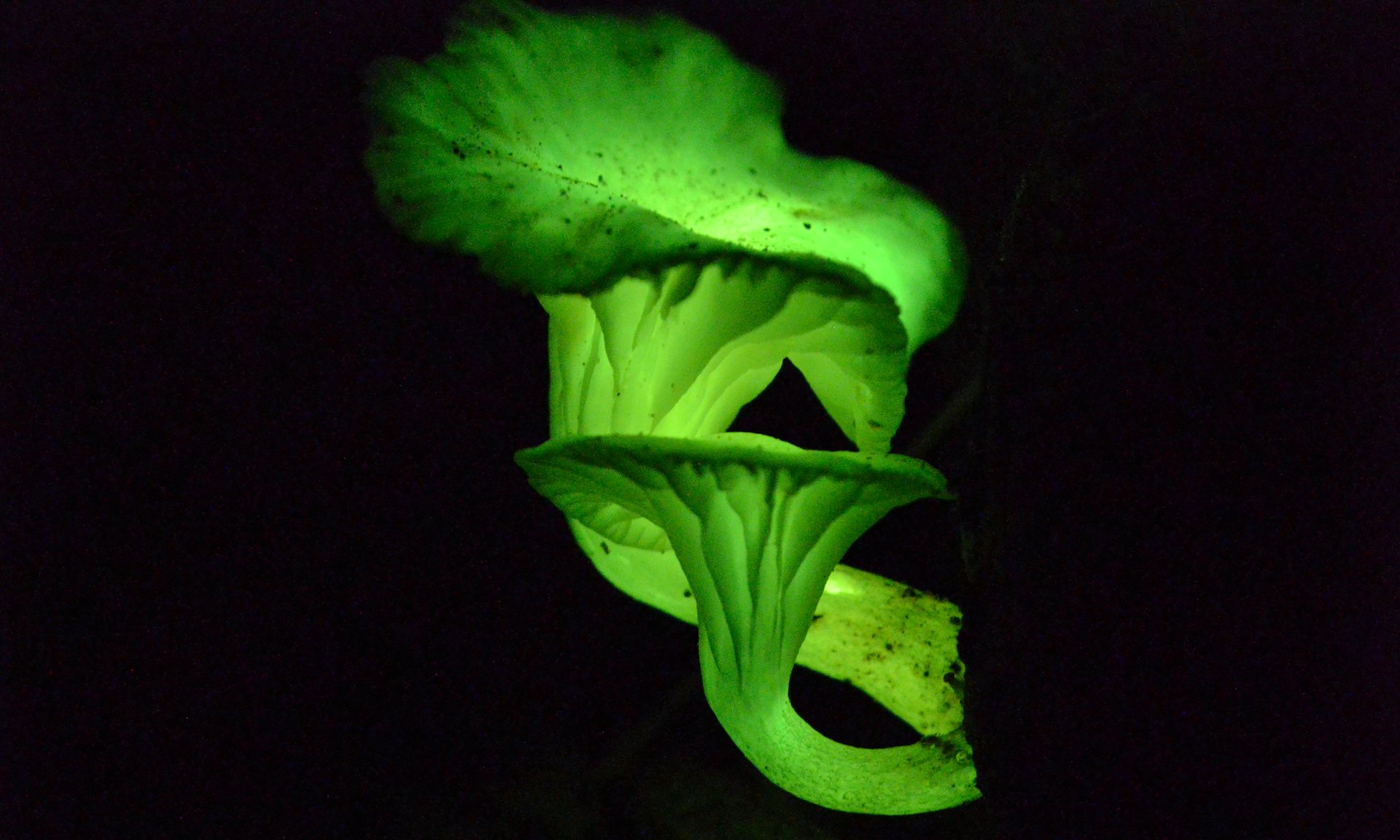Пресс-центр / новости / Наука /
Как исследования светящихся грибов помогут создать деревья, освещающие улицы (The Guardian)
On a moonless night deep in a Brazilian rainforest the only thing you are likely to see are the tiny smears of light from flitting fireflies or the ghostly glow of mushrooms scattered around the forest floor. Both effects are the result of bioluminescence, the peculiar ability of some organisms to behave like living night-lights.
(текст опубликован в The Guardian)

Fungal luciferin could eventually allow the creation of an autonomously luminescent plant. Photograph: Cassius Stevani at the San Paulo University in Brazil.
Bioluminescence has been “invented” dozens of times in evolutionary history and serves a variety of purposes, from attracting mates and luring prey to warding off predators. Its existence in fungi – a rare if not unique case of bioluminescence outside the animal and microbial worlds – has posed more of a mystery. But scientists may now be able to explain not only why certain mushrooms glow in the dark, but how – and in doing so they could be nearer to creating glowing trees as a novel form of street lighting.
Aristotle in 382BC and the Roman scholar Pliny the Elder writing three centuries later both observed the effect of fungal bioluminescence when they described the glowing light of the cold “fire” of damp wood. The ghostly glow later became known as “foxfire”, probably from the Old French word fois meaning “false”, and the phenomenon appeared in many works of literature, including The Adventures of Huckleberry Finn when Tom Sawyer used it to light up a tunnel.
Naturalists in the early 19th century identified fungal growth as the source of the glow from wooden support beams used to shore up mines. Many fungi and mushrooms are now known to glow in the dark, and explanations for why they do it range from it being a useless by-product of metabolism to a sophisticated anti-predator adaptation.
But the best explanation seems to be that the night-light attracts insects and other animals to the fruiting bodies of fungi, who then spread the spores far and wide.Cassius Stevani at the São Paulo University in Brazil and colleagues showed thisby scattering plastic mushrooms on the forest floor fitted with green LED lights that matched the eerie bioluminescence of Neonothopanus gardneri, a splendid mushroom that grows at the base of palm trees. He found the light attracted the sort of insects and other creatures that would be good at spreading spores. They also showed the bioluminescence only occurred at night – ruling out the “useless by-product” theory. “Results indicate that the bioluminescence can attract animals to disperse spores. This additional dispersal mechanism might confer to this fungus some advantage, especially in dense forest,” Stevani says.
The exact method of how mushrooms can generate a spooky glow remained a mystery, in contrast to the elucidation of the light-emitting pigments used by the many other forms of life that can generate bioluminescence.
But now a team from the Institute of Biophysics in Krasnoyarsk in Siberia led by Konstantin Purtov and the Institute of Bio-organic Chemistry in Moscow led by Ilia Yampolsky has finally teased apart the chemical structure of the fungal protein used to generate the ghostly glow of foxfire. They did it by the counterintuitive approach of looking for it in mushrooms that did not glow in the dark because it was here they thought the precursors of the bioluminescence substance, known as luciferin, might be more easily found – and they were right.
“The mechanism of fungal bioluminescence suggests the formation of luciferin from a certain precursor,” Yampolsky says. “It was established that the luciferin precursor is also present in non-luminous forest fungi, and more importantly it is about 100 times more abundant than in the biomass of luminous species. Therefore, it made sense to extract the precursor from non-luminous fungi.”
The term “luciferin” was first identified in the late 19th century by French chemist Raphaël Dubois, working on click beetles and bivalve molluscs. He gave the name luciferin to the substance that can be oxidised in air, with the help of the enzyme luciferase, to emit a greenish-bluish light.
But Yampolsky and his colleagues found that the bioluminescent fungi use a type of luciferin quite different from the eight other classes of molecule already chemically described in the animal and microbial worlds. He and his team effectively discovered the ninth luciferin, and the first to be found in the fungal-plant sphere of life.
“Fungal luciferin is chemically unrelated to other known luciferins, therefore it represents a totally different mechanism of light emission. This is important from the points of view of photochemistry, biochemistry and evolution. Moreover, it gives the possibility to search for an unknown fungal luciferase,” Yampolsky says. “Unlike the other luciferins, fungal luciferin is compatible with plant biochemistry, and I hope that this will eventually allow the creation of an autonomously luminescent plant, one that would not require the external addition of luciferin, but would be able to biosynthesise it by itself,” he says.
This would be a key breakthrough in, for instance, designing a genetically modified tree that could glow in the dark and act as a sustainable source of street lighting. The idea is not as crazy as it may seem. The Glowing Plant Project, the first crowdfunding campaign for a synthetic biology application, is supported by the Harvard geneticist George Church, who once said that “even a weakly glowing flower would be a great icon”.
Author: Steve Connor
Источник: The Guardian
8 июля 2016 года

